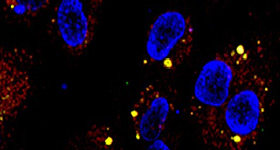Related Research
Analgesia Drug Discovery

The Ajit Lab is interested in pursuing various aspects of epigenetics including DNA methylation, histone modifications, and RNA-mediated gene silencing, all aimed at understanding the molecular mechanisms underlying pain.
Visit the Ajit Lab.
Cancer Drug Discovery

Dr. Hartsough's work is focused on understanding the mechanisms contributing to metastatic progression and susceptibility of cancers to targeted inhibitors. In particular, the lab utilizes melanoma as a model system to investigate 1) the tumor suppressive functions of CADM1 in regulating melanoma invasion, anchorage-independent cell death, and co-stimulation of immune-mediated cytotoxic responses and 2) the mechanisms governing the varied responses of mutant BRAF to inhibitor treatment.
Visit the Hartsough Lab.
Cardiovascular Drug Discovery

Sato Lab
Our research focuses on molecular mechanisms of cardiovascular diseases, with particular emphasis on G-protein coupled receptor signaling and cardiac metabolism. The long-term goal of this work is to delineate the role of inter-organ communication in aberrant cardiac metabolic signaling, and to unveil novel targets for pharmacological intervention. Our team utilizes a wide-range of techniques from biochemical/molecular studies to in vivo genetically-modified mouse models of diabetes and cardiac diseases.
Visit the Sato Lab.
CNS Drug Discovery

Dr. Barker’s primary research interest is in dissecting the neural circuits that contribute to the development of neuropsychiatric illnesses characterized by inflexible behavior. Her lab combines traditional and cutting-edge techniques to investigate how these circuits function in an intact system to mediate behavioral flexibility, and how deficits in control over actions may result from insults such as drug and alcohol exposure.
Visit the Barker Lab.

Current projects in the A. Mortensen Lab include the identification and development of allosteric compounds that enhance the activity of EAAT2 (the main glutamate transporter in the brain) and the examination of potential neuroprotection of these compounds in in vitro and in vivo models. In addition, our lab is interested in mechanisms involved in transport augmentation that could lead to therapies to treat disorders in which excitotoxicity is involved.
Visit the A. Mortensen Lab.

The overarching goal of research at the Ole Mortensen Lab is to develop a clear understanding of the molecules and pathways involved in the pathoetiology of brain disorders and to use this information to develop new therapeutic targets. More specifically, we are focusing our research on the monoamine neurotransmitters dopamine, serotonin, and norepinephrine that all play a central role in modulating most brain activity. We are interested in understanding the regulation of monoaminergic neurotransmission at all levels from the molecular level where we study monoaminergic proteins to the systems level where we study behaviors modulated by monoamines.
Visit the Ole Mortensen Lab.
Infectious Disease Drug Discovery

The Gaskill lab examines the role of myeloid cells in several neurological and inflammatory diseases, including HIV infection and substance use disorders. Our projects focus specifically on the in vitro examination of the molecular mechanisms regulating the involvement of myeloid cells, such as macrophages and microglia, in these disease processes. We assess these disparate questions using cutting edge molecular systems and analyses, such as high-content imaging and inducible pluripotent stem cell culture, alongside analyses of primary macrophages and myeloid cell lines. This enables careful evaluation of myeloid functions such as phagocytosis and cytokine production, HIV infection dynamics and transcriptional modulation and the signaling transduction pathways and epigenetic factors underlying these changes. This provides the foundation for the development of new therapeutic strategies to directly combat these insults or to boost CNS immune function.
Visit the Gaskill Lab.

The Klase Lab is interested in the overlapping problems of HIV-1 transcription, HIV-1 neuropathogenesis and substance use disorders. We are working on understanding how prescription benzodiazepines alter chromatin and affect viral gene expression; determining how alteration of miRNA expression by the virus may drive neuropathogenesis; describing the mechanism whereby substances of abuse exacerbate HIV-1 associated neurodegenerative disorders and studying the immune mechanisms that allow a small fraction of HIV-1 infected individuals to control the virus in the absence of therapy.
Visit the Klase Lab.
Oncology Drug Discovery

Ongoing projects in the Fatatis Lab aim to understand the molecular and functional interactions underpinning the metastatic process, and identify molecular targets for effective therapies to counteract the dissemination and growth of cancer cells.
Visit the Fatatis Lab.